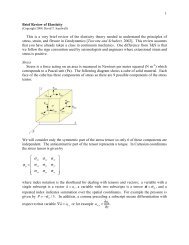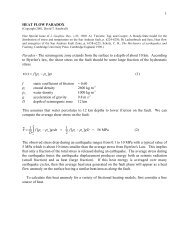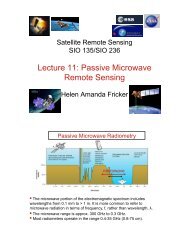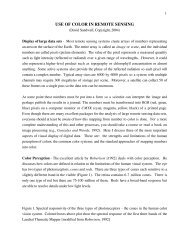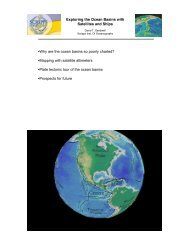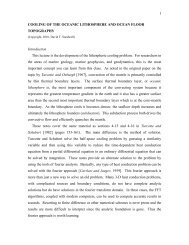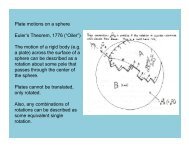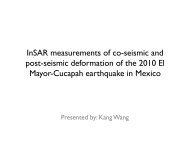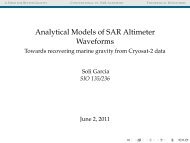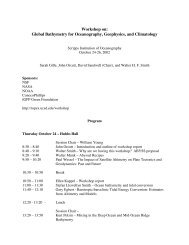Temperature as a function of depth and time Paul Evans & Christine ...
Temperature as a function of depth and time Paul Evans & Christine ...
Temperature as a function of depth and time Paul Evans & Christine ...
Create successful ePaper yourself
Turn your PDF publications into a flip-book with our unique Google optimized e-Paper software.
<strong>Temperature</strong> <strong>as</strong> a <strong>function</strong> <strong>of</strong> <strong>depth</strong> <strong>and</strong> <strong>time</strong><strong>Paul</strong> <strong>Evans</strong> & <strong>Christine</strong> WittichSIO234: Geodynamics, Pr<strong>of</strong>. S<strong>and</strong>wellFall 2011
Periodic Heating <strong>of</strong> the Surface <strong>of</strong>the Earth• Why is it the wine cellar problem?• Wine ages best when kept at a constant temperature• If we underst<strong>and</strong> the heating that occurs at the surface <strong>of</strong>the Earth, we can choose an appropriate cellar <strong>depth</strong>Other Applications• Geodynamics• Determine diffusivity, , <strong>of</strong> rocks <strong>and</strong> soil• Structural Engineering• Determine required foundation <strong>depth</strong> to prevent heaving
Defining the ProblemT SAtmosphereEarthxzFIND: T (z , t)Note:
Solving for T (z, t)
Solving for T (z, t)• Derivative <strong>as</strong> a <strong>function</strong> <strong>of</strong> <strong>time</strong>[3]• Second derivative <strong>as</strong> a <strong>function</strong> <strong>of</strong> <strong>depth</strong>[4]
Solving for T (z, t)
Solving for T (z, t)• Because temperature must decre<strong>as</strong>e, or decay, <strong>as</strong><strong>depth</strong> incre<strong>as</strong>es, we can reject the positive root <strong>of</strong> ksuch that[5]• Note :→ Therefore[6]
Solving for T (z, t)
Solving for T (z, t)
Solving for T (z, t)
Solving for T (z, t)• Using boundary condition <strong>of</strong> T(0, t) = T S• The temperature variation in the Earth due theperiodic surface temperatures is
What determines the near surfacetemperature in the Earth?• T o – average surface temperature
What determines the near surfacetemperature in the Earth?• T o – average surface temperature• – ½ total temperature range (amplitude)
What determines the near surfacetemperature in the Earth?• T o – average surface temperature• – ½ total temperature range (amplitude)• –decay <strong>of</strong> temp. variation with <strong>depth</strong> (κ)
What determines the near surfacetemperature in the Earth?• T o – average surface temperature• – ½ total temperature range (amplitude)• –decay <strong>of</strong> temp. variation with <strong>depth</strong> (κ)• cosine – periodic change in temperature
What determines the near surfacetemperature in the Earth?• T o – average surface temperature• – ½ total temperature range (amplitude)• –decay <strong>of</strong> temp. variation with <strong>depth</strong> (κ)• cosine – periodic change in temperature• – ph<strong>as</strong>e shift due to <strong>time</strong> lag betweensurface temp. <strong>and</strong> temp. at <strong>depth</strong> z
How deep do we put a wine cellar?• Wine cellar should be put at a <strong>depth</strong> wheretemperature fluctuations due to periodic surfacechanges will be minimal• Apply concept <strong>of</strong> skin <strong>depth</strong>• Skin Depth, z o• <strong>depth</strong> at which temperature fluctuation is 1/e <strong>of</strong> the surfacetemperature fluctuation• 1/e ≈ 0.37, which therefore represents a 63% reduction intemperature fluctuation
Solving for Skin Depth• When looking at T (z, t), consider only the termscontaining z• We are concerned with the <strong>depth</strong>, z o , that is necessary toreduce the maximum surface value fluctuation• Maximum occurs when
Solving for Skin Depth• To determine z o , setNote: The <strong>depth</strong> z o can e<strong>as</strong>ilybe adjusted to represent adifferent reduction in surfacetemperature fluctuation byreplacing 1/e with thedesired valuei.e. – replace 1/e with 0.10 for<strong>depth</strong> at which 90%reduction occurs
What constants determine z o ?1. = thermal diffusivity [m 2 /s]• k = thermal conductivity [W/m K]• = density [kg/m 3 ]• c = specific heat [J/kg K]• These values are physical properties <strong>of</strong> the localgeology
What constants determine z o ?2. = circular frequency• Recall<strong>and</strong>• = period <strong>of</strong> concern [sec]• varies depending on what <strong>time</strong> scale is <strong>of</strong>concern
What constants determine z o ?• values for different <strong>time</strong> scales provided in the tablebelowDiurnal Weekly Annual Glacial1 day 7 days 1 year 40,000 yearsτ (sec) 86400 604800 31536000 1.261E+12f (sec -1 ) 1.157E-05 1.653E-06 3.171E-08 7.927E-13ω (rad/s -1 ) 7.272E-05 1.039E-05 1.992E-07 4.981E-12• As becomes larger, gets smaller• is inversely related to z o⇒ Wine cellar <strong>depth</strong> must incre<strong>as</strong>e <strong>as</strong> incre<strong>as</strong>es
Simplified T (z, t)• By substituting z o into T (z, t)
Related to Cl<strong>as</strong>s Discussion• Stated in cl<strong>as</strong>s that a good approximation <strong>of</strong> the <strong>depth</strong><strong>of</strong> propagation <strong>of</strong> a temperature change, L, over a <strong>time</strong>,t is• Let t→ It can be seen that theapproximate method willquickly yield a result, L, <strong>of</strong>the same magnitude <strong>as</strong> z o
Attenuation Depth b<strong>as</strong>ed on SoilProperties• Thermal diffusivity – soil property• Frequency – <strong>time</strong>-dependentIce S<strong>and</strong>y Soil Clay Soil Peat Soil RockΚ (m 2 /s) 1.16 x 10 -6 0.24 x 10 -6 0.18 x 10 -6 0.10 x 10 -6 1.43 x 10 -6http://apollo.lsc.vsc.edu/cl<strong>as</strong>ses/met455/notes/section6/2.htmlDiurnal Annual Glacialω (s -1 ) 7.27x 10 -5 1.99 x 10 -7 4.98 x 10 -12
Attenuation Depth• How deep is the attenuation <strong>depth</strong> or skin <strong>depth</strong>?• Represents <strong>depth</strong> where surface temperature can onlyaffect by 37%Ice S<strong>and</strong>y Soil Clay Soil Peat Soil RockDiurnal 0.179 m 0.081 m 0.070 m 0.052 m 0.198 mAnnual 3.412 m 1.552 m 1.344 m 1.002 m 3.789 mGlacial 682 m 310 m 268 m 200 m 757 m
Wine Cellar Depth• Attenuation <strong>depth</strong> doesn’t tell us everything we needto know: , ∆ cos • Want cellar to remain unaffected by annualtemperature changes• cos 1.0 <strong>as</strong> the maximum• Can obtain T(z) relationship which will become steadyat a certain dept
C<strong>as</strong>e Study – Long Isl<strong>and</strong>, NY• Suffolk County, New York• Active Wine Country!http://maps.google.com/
C<strong>as</strong>e Study – Long Isl<strong>and</strong>, NY• Soil Type: well-drained, medium-moderately coarsetextured soils• S<strong>and</strong>y Soil: κ = 0.24 x 10 -6• z 0 = 1.552 mNew York Online Soil Survey. Retrieved from: http://soils.usda.gov/survey/online_surveys/new_york/
C<strong>as</strong>e Study – Long Isl<strong>and</strong>, NY• Average Annual Temp• T 0 = 53.5°F = 11.9°C• Average Range <strong>of</strong> Temp• ΔT = 21°F = -6.1°C• Surface <strong>Temperature</strong>:T s (t) = T 0 - ΔT cos(ωt)T s (t) = 11.9-6.1 cos(1.99E-7*t)http://www.weather.com/weather/wxclimatology/monthly/graph/42689:20
C<strong>as</strong>e Study – Long Isl<strong>and</strong>, NY• Recall: , ∆ cos • Determined: temperature <strong>and</strong> attenuationparameters• Maximum effects require cosine term to 1• Now have:• maximum temperature effects along <strong>depth</strong>
C<strong>as</strong>e Study – Long Isl<strong>and</strong>, NY
How accurate is this?Many <strong>as</strong>sumptions made:• Soil is homogeneous throughout <strong>depth</strong>s• Soil thermal properties are accurate• Water table is sufficiently low• Heat flow is 1-dimensional• Cosine accurately represents the annual surfacetemperature cycle• Can look a bit further at this…
Borehole Comparison• To take a look at the cosine representation• Me<strong>as</strong>ured borehole-thermistor data• Thanks to the National Snow <strong>and</strong> Ice Data Center!• Ilulissat, Greenl<strong>and</strong>• Model forcing <strong>function</strong> <strong>as</strong> a cosine• Compare!• Remember: Our model is only ever <strong>as</strong> good <strong>as</strong> ourmaterial (soil) properties!• Soil type: Arctic brown soil• Assume a diffusivity slightly greater than s<strong>and</strong>y soil• κ = 0.28
Borehole Comparison• NSIC provided surface temperature data• Fit a cosine <strong>function</strong>!20Surface <strong>Temperature</strong> Signal Determination<strong>Temperature</strong> [deg C]100-10-20Me<strong>as</strong>ured Surface <strong>Temperature</strong>T s= -3.5-11cos(2π t)-300 2 4 6 8 10 12 14Time [yr]
Borehole Comparison• Approximate surface forcing <strong>function</strong>:• T s (t) = -3.5 - 11 cos(2πt) [yr]• Attenuation: = 1.648 m• Depths Sampled:• 0.25 m• 2.5 m• 3.0 m• 8.0 m• 9.0 m• 15.0 m
Borehole Comparison6Modeled <strong>Temperature</strong> at Depth42<strong>Temperature</strong> [deg C]0-2-4-6-8-10-12-140 0.5 1 1.5 2 2.5 3 3.5 4 4.5Time [s]x 10 8
Borehole Comparison6Borehole <strong>Temperature</strong>s at Depth4<strong>Temperature</strong> [deg C]20-2-4-6-8-100 0.5 1 1.5 2 2.5 3 3.5 4 4.5Time, [s]x 10 8
Borehole ComparisontemptemptempDepth = 0.25m50-5-10Me<strong>as</strong>uredModeled-150 0.5 1 1.5 2 2.5 3 3.5 4 4.5<strong>time</strong>x 10 8Depth = 3.0m50-5-10Me<strong>as</strong>uredModeled-150 0.5 1 1.5 2 2.5 3 3.5 4 4.5<strong>time</strong>x 10 8Depth = 15.0m50-5-10Me<strong>as</strong>uredModeled-150 0.5 1 1.5 2 2.5 3 3.5 4 4.5<strong>time</strong>x 10 8
Conclusions• Wine cellars ~ 8-10m beneath ground in Long Isl<strong>and</strong>• <strong>Temperature</strong> at <strong>depth</strong> can be predicted• Cosine – a decent approximation to the annualtemperature fluctuations• Soil properties are important!• Even if model at surface is perfect, knowledge <strong>of</strong> soil at <strong>depth</strong>sis critical.
References• Maps.google.com• www.weather.com• New York Online Soil Survey. Retrieved 25-Oct 2011 from:http://soils.usda.gov/survey/online_surveys/new_york• B<strong>as</strong>ics <strong>of</strong> a Soil Layer Model. Retrieved 25-Oct 2011 from:http://apollo.lsc.vsc.edu/cl<strong>as</strong>ses/met455/notes/section6/2.html• National Snow <strong>and</strong> Ice Data Center. Shallow Borehole <strong>Temperature</strong>s, Ilullisat, Greenl<strong>and</strong>.Retrieved 25-Oct 2011 from: http://nsidc.org/data/ggd631.html• Turcotte, D. (2002). Geodynamics. Cambridge New York: Cambridge University Press. Pgs149-152.• Taler, J. (2006). Solving direct <strong>and</strong> inverse heat conduction problems. Berlin New York:Springer. Pgs 366-374.• Soil Mechanics: Design Manual 7.1. Alex<strong>and</strong>ria, VA: Dept. <strong>of</strong> the Navy, Naval FacilitiesEngineering Comm<strong>and</strong>, 1982.
<strong>Temperature</strong> <strong>as</strong> a <strong>function</strong> <strong>of</strong> <strong>depth</strong> <strong>and</strong> <strong>time</strong><strong>Paul</strong> <strong>Evans</strong> & <strong>Christine</strong> WittichSIO234: Geodynamics, Pr<strong>of</strong>. S<strong>and</strong>wellFall 2011



